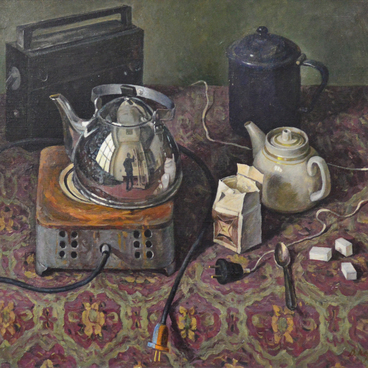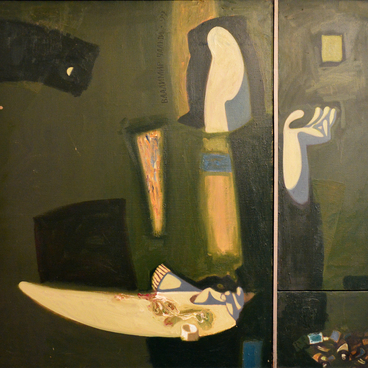Speaking of contemporary painting it’s hard to ignore Yury Popkov’s works. Popkov is a painter from Moscow, a member of the New Era Academy of Arts, a corresponding member of the International Academy of Culture and Art. He is a nephew of a famous Sixtiers painter Viktor Popkov, who was his first mentor (afterwards Yury studied at the Moscow Academic Art School in the Memory of 1905). The Kurgan museum has Popkov’s painting By the Spring, made in 2002, in its collection.
“There are three qualities required for making a good painting. They are the idea, composition and a beautiful colouristic basis”, said Yury Popkov about his works. The artist is occupied with the questions of moral and spirituality, religion and faith. The titles of his works speak for themselves: In Search for Mercy, Humble Path, Prayer, Angel in the City, Blessing. His paintings usually have no definite plot, action, or drama. By the Spring is a bright example of this tendency. Light and colour are the main instruments in the painting. Bright, hyperbolized shadows, unusual for a sunny day, are the specific features of Popov’s art. It makes the impression that the images are lit with rough flashes of lightning, making the shapes look flat and light-struck.
The work itself is a certain parable, a story where the people having arrived to the spring discovered it to be dried up. The growing tree turned out to be dry as well, and there’s not a scintilla of rain at the sky, only a boy in the white clothes, unnoticed by everyone, pours water out of his open palms. The artist’s beloved symbols, such as the tree as a symbol of life, a stone as a symbol of faith, are present at the painting. According to the author’s idea, people who are starved of drink are looking for the source of drinking water instead of having the spiritual thirst. In Popkov’s work the child is a symbol of a divine grace and a God’s messenger. It’s important that a girl also dressed in white, who gets on her knees before the angel, is the one who gets the water. On the background the artist placed the white bodies of the churches with the golden domes. In such a way a genre scene got a deep spiritual meaning.
“There are three qualities required for making a good painting. They are the idea, composition and a beautiful colouristic basis”, said Yury Popkov about his works. The artist is occupied with the questions of moral and spirituality, religion and faith. The titles of his works speak for themselves: In Search for Mercy, Humble Path, Prayer, Angel in the City, Blessing. His paintings usually have no definite plot, action, or drama. By the Spring is a bright example of this tendency. Light and colour are the main instruments in the painting. Bright, hyperbolized shadows, unusual for a sunny day, are the specific features of Popov’s art. It makes the impression that the images are lit with rough flashes of lightning, making the shapes look flat and light-struck.
The work itself is a certain parable, a story where the people having arrived to the spring discovered it to be dried up. The growing tree turned out to be dry as well, and there’s not a scintilla of rain at the sky, only a boy in the white clothes, unnoticed by everyone, pours water out of his open palms. The artist’s beloved symbols, such as the tree as a symbol of life, a stone as a symbol of faith, are present at the painting. According to the author’s idea, people who are starved of drink are looking for the source of drinking water instead of having the spiritual thirst. In Popkov’s work the child is a symbol of a divine grace and a God’s messenger. It’s important that a girl also dressed in white, who gets on her knees before the angel, is the one who gets the water. On the background the artist placed the white bodies of the churches with the golden domes. In such a way a genre scene got a deep spiritual meaning.

